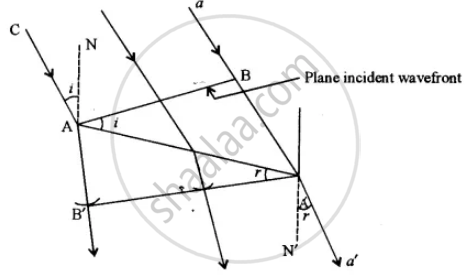Advertisements
Advertisements
Question
Derive Snell’s law of refraction using Huygens’s wave theory.
Solution

AB - Incident wavefront
A'B' - Refracted wavefront
i = ∠CAN = ∠BAA'
r = ∠NA'a' = ∠AA'B'
`therefore "sin i"/"sin r" = "BA′"/"AB′"`
BA' = V1 t ; AB = V2t
`therefore "sin i"/"sin r" = ("V"_1)/("V"_2)`
`("V"_1)/("V"_2)` is called refractive index, it's constant for two particular optical medium.
∴ `"sin i"/"sin r" = "constant"`
APPEARS IN
RELATED QUESTIONS
Derive Snell’s law on the basis of Huygen’s wave theory when the light is travelling from a denser to a rarer medium.
Calculate the speed of light in a medium whose critical angle is 45°. Does critical angle for a given pair of media depend on the wavelength of incident light ? Give reason.
Find a critical angle for glass and water pair, given the refractive index of glass, is 1 ·62 and that of water is 1 ·33.
Define the term, “refractive index” of a medium. Verify Snell’s law of refraction when a plane wavefront is propagating from a denser to a rarer medium. Solution
According to Snell’s law, ______.
For small angles Snell’s law becomes ______.
Using Huygen’s wave theory of light, prove Snell’s law of refraction of light.
Draw the shape of refracted wavefront when the plane incident wave undergoes refraction from optically denser medium to rarer medium. Hence prove Snell’s law of refraction.
The mixture a pure liquid and a solution in a long vertical column (i.e, horizontal dimensions << vertical dimensions) produces diffusion of solute particles and hence a refractive index gradient along the vertical dimension. A ray of light entering the column at right angles to the vertical is deviated from its original path. Find the deviation in travelling a horizontal distance d << h, the height of the column.
A ray of light is incident on a glass prism of refractive index µ and refracting angle A. If it just suffers total internal reflection at the other face, obtain a relation between the angle of incidence, angle of prism and critical angle.
